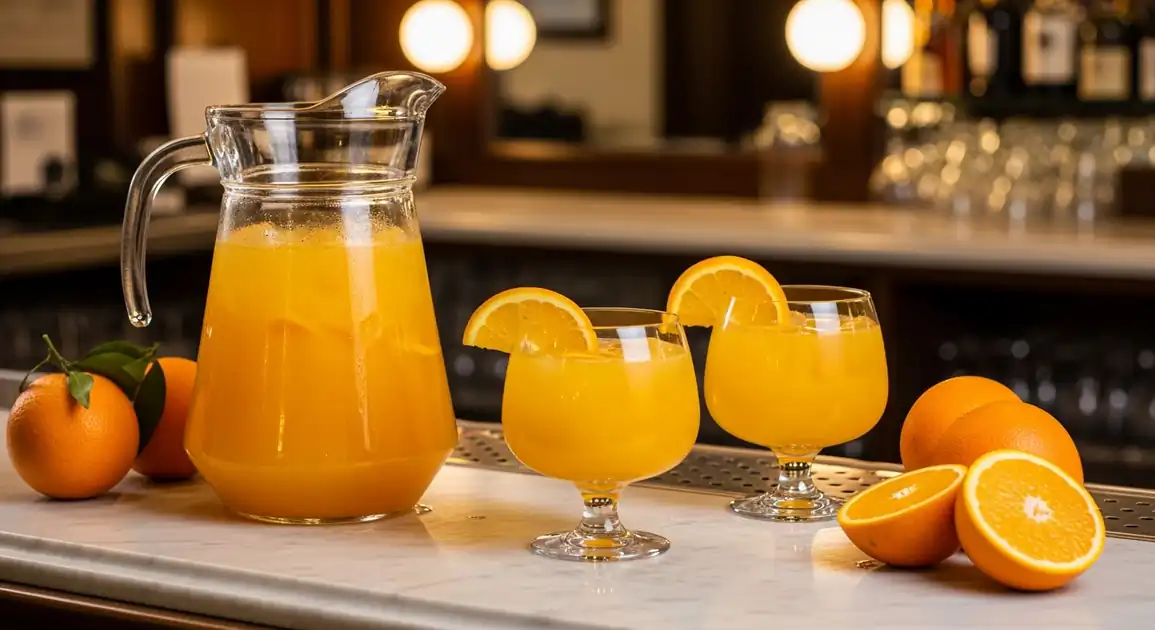Agua de Valencia (Valencian Water Cocktail)
Agua de Valencia

Description
Agua de Valencia is fundamentally a Valencian specialty. While you might find it on menus in cocktail bars in other major Spanish cities like Madrid or Barcelona, it's far less common and may not always be prepared authentically compared to its prevalence and cultural significance in Valencia.
Dietary Information
Serving information
Serving style
Served chilled in cocktail glasses or shared amongst a group from a pitcher ('jarra'). Garnished with an orange slice.
Quick facts
Bars/Restaurants: Typically from midday until late night (12 PM - 2 AM or later).
Safety Tips
What to Look For
-
Made with freshly squeezed orange juice ('zumo natural')
Ensures best flavor and quality. Avoid places using bottled or concentrated juice.
-
Served well-chilled
The cocktail should be very cold for optimal taste and refreshment.
-
Prepared in a clean bar environment
Good hygiene practices by the staff and clean serving ware are essential.
-
Transparent pricing
Prices per glass and pitcher should be clearly indicated on the menu.
-
Balanced flavor profile
A well-made version shouldn't taste overwhelmingly of cheap alcohol; the orange and Cava should shine.
What to avoid
-
Drinking excessively due to deceptive taste
The sweet, fruity flavor masks the high alcohol content. Pace yourself and be aware of its strength.
-
Suspiciously cheap offers
Extremely low prices might indicate use of low-quality spirits, artificial juice, or improper preparation.
-
Places using bottled or artificial orange juice
Significantly impacts the authentic flavor and quality.
-
Pre-mixed batches sitting out at room temperature
Best prepared fresh or kept well-chilled before serving.
-
Drinking on an empty stomach
Consuming food alongside helps manage the alcohol effects.
Price information
Price range
Budget tips
- Prices are per glass ('copa'). Pitchers ('jarras') offer better value for groups (approx. €15-30).
- Prices are generally higher in major tourist centers outside Valencia if found.
- Look for happy hour deals ('hora feliz') in some bars.
Value indicators
- Use of fresh Valencian oranges (if specified).
- Good quality Cava used.
- Balanced taste, not overly sweet or alcoholic.
- Served properly chilled.
Where to Find This Dish
Cocktail Bars in Major Cities
Trendy or classic cocktail bars might feature it.
Madrid (Malasaña, Chueca), Barcelona (El Born, Gràcia)
Evening, Night
Valencian-Themed Restaurants
Restaurants specializing in Valencian cuisine outside Valencia might offer it.
Various locations
Lunch, Dinner
Vendor Tips
- Authenticity is highest in Valencia.
- Ask about the ingredients, especially the juice freshness, if ordering outside Valencia.
- It might be listed under 'Cocktails' or 'Specialty Drinks'.
How to Order
Regional Variations
-
Spirit Ratio Variations
(Variaciones en Proporción de Licores)
Different bars may use slightly different ratios of gin, vodka, and Cava, affecting the overall strength and flavor balance.
-
Sweetness Level
(Nivel de Dulzor)
Some preparations are sweeter (more sugar added) while others are tarter, depending on the natural sweetness of the oranges and the bartender's preference.
-
Inclusion of Triple Sec/Cointreau
(Con Triple Seco/Cointreau)
Some recipes might substitute or add Triple Sec or Cointreau for extra orange flavor and sweetness, deviating slightly from the classic gin/vodka combination.
-
Serving with Ice
(Servido con Hielo)
While traditionally chilled without ice in the pitcher, some places might serve individual glasses with ice, which can dilute the drink over time.
Cultural context
History
The cocktail was created in 1959 at the Café Madrid de Valencia (which still exists) by its owner, Constante Gil. Initially made for a group of Basque travelers tired of ordering their usual drinks, it remained a local secret for years before gaining wider popularity in Valencia during the 1970s nightlife scene. It's now considered an emblematic drink of the city.
Local significance
Primarily significant to Valencia, representing its local produce (oranges) and vibrant social life.
Eating customs
- Sipped and enjoyed socially.
- Often accompanied by light snacks or tapas.